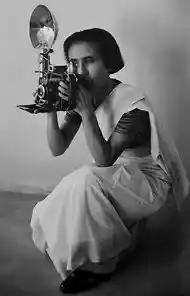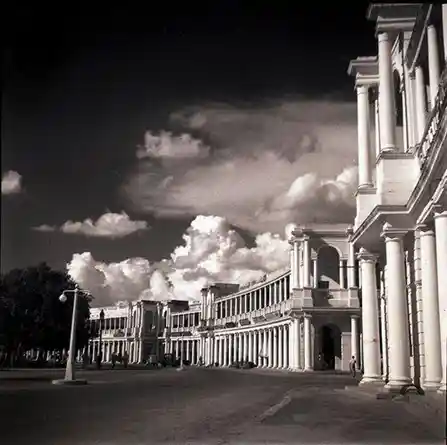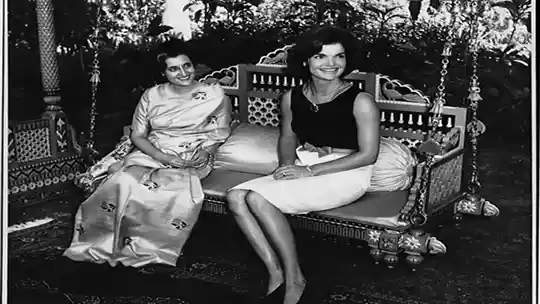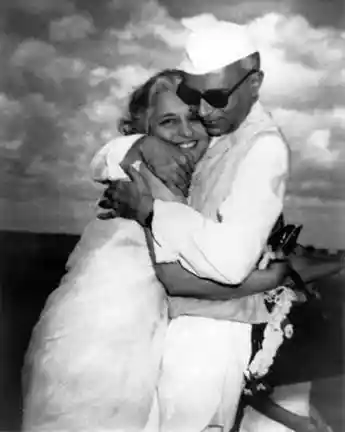The woman behind the camera
In the 1940s, when the nation was going through turmoil and the profession of journalism was dominated by men, a women photographer rose to prominence on nothing except the merit of her work. She was Homai Vyarawalla, the first female photojournalist of India, who would not just make history, but document it too.

Homai Vyarawalla; Image Source: Wikipedia
Homai Vyarawalla was born in 1913 in a Parsi family in Navsari, Gujarat, because of the theatre background of her father, her family moved a lot. Home came from a family of artists and she was trained in classical composition. She married Manekshaw Vyarawalla, a freelance photojournalist for newspapers. In 1941 she along with her husband was hired by the British Information Service to open its New Delhi bureau the following year. As a result of her and her husband’s profession and the turbulent times they were living in, Homai became a witness to several important political events, and she grabbed the opportunity to capture them. However, she published most of her photographs under the pseudonym Dalda 13.
There’s a story behind this pseudonym too. She had to use a pseudonym because at that age and time women photojournalists were unheard of. She chose the number 13 because of its significance in her life. She was born in 1913, She met her husband at the age of 13 and her first car’s number plate read DLD13 from where she goes the DALDA part of her pseudonym, Equipped with her pseudonym Homai Vyarawalla would go on to make history as India’s first woman photojournalist.
Initially, she started working as her husband’s assistant, but soon after she ventured on her own. She would cycle around New Delhi with her camera, a sight rare in those days. She exemplified the image of a modern independent woman, a woman who wasn’t confined to the walls of her home despite her talent but someone who was out on the streets, documenting a nation in transition.
She captured important portraits of national leaders and political events such as the first flag hoisting ceremony, the departure of Lord Mountbatten from India, and the funerals of Mahatma Gandhi and Lal Bahadur Shastri. Along with these she also captured important state visits of World leaders such as Dwight D. Eisenhower, Ho Chi Minh, Nikita Khrushchev, and the Shah of Iran. She also photographed the 14th Dalai Lama for Life Magazine in 1956.
However, she didn’t confine herself just to courts and political meetings. She also documented the lives of ordinary people as well. She photographed the city of Bombay and Delhi and beautifully put forward the contrast between the two, something that is apparent even now. She photographed ordinary people involved in leisure activities, social gatherings, cultural events, etc. She loved to photograph and she carefully preserved a vast photo archive of her own.
Her contribution to photojournalism is unmatched. She led the foundation for female journalist all over the country, her boldness and resourcefulness was an inspiration. As she undertook the task of photographing a nation that was just being born, her work became invaluable for anyone even remotely interested in the study of modern Indian history. For her unparalleled contribution, she was awarded Padam Vibhushan, India’s highest civilian honour in 2011. After her husband’s death she quit photography, she spent most of her time cataloguing and curating her photo archive, which she then donated to the Alkazi Foundation of Art, in 2010. While she might have not taken photographs in the later years of her life, she would always remain the woman behind the camera.
As the only female photojournalist of her time, She attracted the attention of a lot of influential people, including India’s first prime minister Pandit Jawahar Lal Nehru. Nehru acknowledged her work and admired her ingenuity. In her biography, she also recalls how Nehru loved to be photographed, and she had the chance to capture some private moments of national leaders, One of her favourites was Nehru hugging his sister Vijaya Lakshmi Pandit while receiving her at the airport.
While it was an uphill struggle for her to survive as the only female professional in a field dominated by She had a certain advantage over them too. She was more approachable and less threatening to her subjects, especially if they were female. And while she understood the importance of photographing a candid moment, she also believed in giving certain dignity to her subjects. So, she interacted with them, talked to them, and put them at ease before they got photographed. As such, she wasn’t obtrusive or aggressive in her profession, unlike her male counterparts. She took some of the most well-composed and gentle images of powerful women of her time which including Eleanor Roosevelt, a young queen Elizabeth II and Jacqueline Kennedy.

Connaught Place was captured by Homai Vyarawalla during the partition of India; Image source: VYARAWALLA/ALKAZI COLLECTION OF PHOTOGRAPHY

Indira Gandhi sits with Jackie Kennedy during a state visit in 1962; Image source; VYARAWALLA/ALKAZI COLLECTION OF PHOTOGRAPHY

Pandit Jawaharlal Nehru greets his sister Vijaya Lakshmi Pandit at the airport; Image source: HOMAI VYARAWALLA/ALKAZI COLLECTION OF PHOTOGRAPHY


